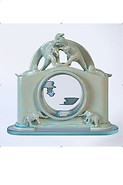_edited.jpg)


.png)


'Antiantrop', 'Silt', 'Chapel'
(object series, 2021-2025)
In the Anti-Anthrop series, the artist to some extent combines theatrical and architectural models with what resembles an archaeological find or an object of material culture—something one could easily imagine on display in a classical museum, i.e., a place where it has been removed from its historical context in favor of the museum’s timelessness.
In almost all of the objects in the Anti-Anthrop series, Fedora uses real 19th-century Orthodox icon cases (kiots). A kiot is a special decorated cabinet (often with doors) or a glass-fronted shelf used to display icons. The kiot is traditionally seen as a descendant of the Ark of the Covenant from the Jerusalem Temple. It embodies both cultural and religious contexts, which in earlier stages of human development were indistinguishable—blended together within the perspective of the divine, whose totality governed every aspect of human existence. Today, however, the kiot points rather to the absence of that former totality—to the end of the all-defining authority of God.
On the other hand, all the works in this series also feature small toy figurines of dinosaurs and other animals. Childhood and play—according to Walter Benjamin, the philosopher, essayist, and noted collector of children’s toys—are the means through which the child interacts with surrounding reality, learns to understand it, and begins to transform it.
Thus, in Fedora Akimova’s Anti-Anthrops, we observe a dichotomy between the elevated solemnity and dogmatism of the religious context (embodied by the kiot) and the curiosity and immediacy of childhood—expressed through play with toys. These works pose questions about possible alternatives and utopias in which the human being is no longer at the top of a hierarchical ladder built upon the subjugation of other species, but rather engages in horizontal relationships with them.
“. . . It looks as if alien artifacts are somehow imitating our way of producing meaning. But that’s not the case. This is not a copy of our consciousness by another intelligence, not a dreary non-human everyday life that differs from ours only by being more monotonous and closer to a dead end. Nor is it a simulation of the production of art, sacredness, or meaning. It's better not to touch the notion of meaning at all — the objects have nothing to do with it: they do not explore it, produce it, or imitate it. . .”
“. . . The everyday of the present returns in artifacts of unclear origin, invoking archaeology as a kindred stylistic device — and as a similarly non-existent infinite future. The archaeological texture lends factual credibility to something that never existed, making tangibly dense the overly abstract distance of a time unimaginably far beyond the human — too abstract due to the absence of analogies in human experience. Like the campfire in Agamben’s story, which remains when all memory of the original meaning has been irrevocably lost. . .” (Aleksandr Evangeli)
Chapel', 2021-2022









Antiantrop, 2021-2025










.jpg)
.jpg)









Silt, 2021
















.jpg)
.jpg)


